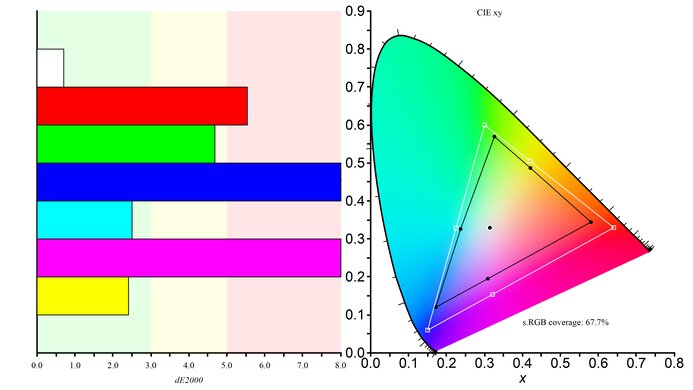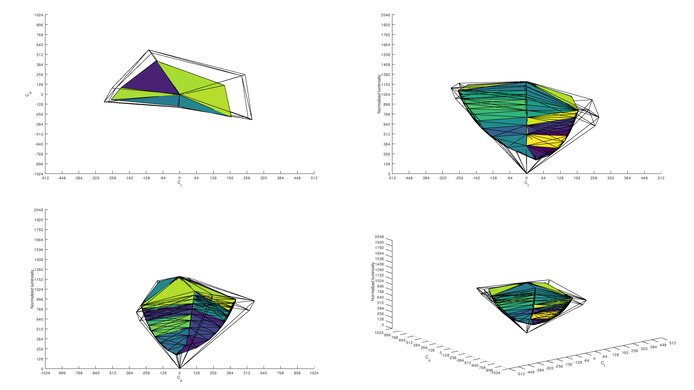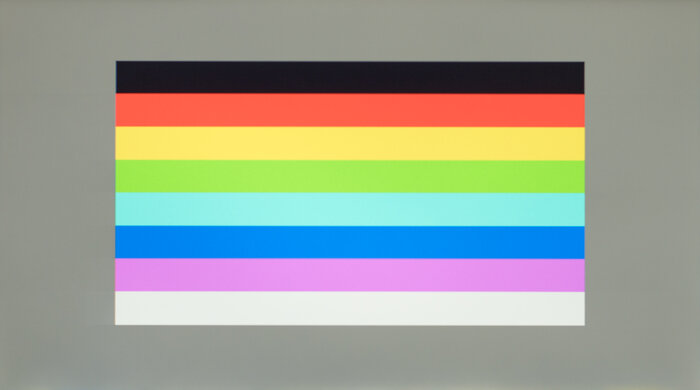The Lepow Z1 is a mediocre portable monitor that's best-suited for mobile office use. A bit larger than a typical tablet, it has great portability, although this model doesn't have a built-in battery, so you have to plug it in for power, either through USB-C or to a wall adapter. The small size and relatively high resolution give it great text clarity, and it has outstanding gradient performance. Unfortunately, there are some serious issues, including terrible response times, poor accuracy out of the box, and a narrow color gamut. There's an updated version of this monitor, the Lepow Z1 Gamut, with a much wider color gamut. These issues make it a less versatile display overall, as it's not a great choice for gaming or color-critical needs, like media creation.
Our Verdict
The Lepow Z1 is a mediocre monitor overall. It's best-suited as a portable office monitor, great if you want a bit more screen real estate when working from a laptop. Unfortunately, this isn't a good choice for media creation, multimedia, or gaming, as it has issues with color accuracy, even after calibration, a narrow color gamut, and terrible response times.
- Amazing gray uniformity.
- Good reflection handling.
- Great text clarity.
- Terrible response times.
- Inaccurate colors, even after calibration.
- Very bad ergonomics.
- Limited 60Hz refresh rate and no advanced gaming features.
The Lepow Z1 is an okay portable office monitor. It has a relatively high pixel density and great text clarity, good reflection handling, amazing gray uniformity, and low input lag. Unfortunately, the ergonomics are terrible, which we expect for a portable monitor, and the viewing angles are mediocre, so it's difficult to place in an ideal viewing position. It also can't display some colors accurately, so if your work relies on accurate colors, this might not be a good choice.
- Amazing gray uniformity.
- Good reflection handling.
- Great text clarity.
- Inaccurate colors, even after calibration.
- Very bad ergonomics.
The Lepow Z1 is a disappointing gaming monitor that most gamers should avoid. Although there's relatively little input lag, the response times are terrible, and any fast-moving objects appear blurry and have a long blur trail behind them. It might not bother those playing slower, turn-based games, but we don't recommend gaming on this monitor. It can be helpful as a second monitor when gaming, though, as you can look up hints while gaming on your main display.
- Amazing gray uniformity.
- Good reflection handling.
- Terrible response times.
- Very bad ergonomics.
- Limited 60Hz refresh rate and no advanced gaming features.
The Lepow Z1 is a mediocre monitor for multimedia. The small size isn't great for sharing videos, and it has terrible ergonomics, which we expect for a portable display. It has mediocre viewing angles, so it's hard to place it in an ideal viewing position. Unfortunately, there are significant issues with color accuracy, and it has a narrow color gamut, so videos don't look their best. Although it supports HDR, it has a poor HDR color gamut and can't get very bright.
- Outstanding gradient handling with no banding.
- Amazing gray uniformity.
- Good reflection handling.
- Disappointing color gamut.
- HDR doesn't add very much.
- Terrible response times.
- Inaccurate colors, even after calibration.
- Very bad ergonomics.
The Lepow Z1 is a mediocre display for media creation, as some issues could be deal-breakers for some people. It has amazing gray uniformity and superb gradient handling. On the other hand, it has a disappointing SDR color gamut, and some noticeable color issues can't be corrected through calibration, so if your work requires accurate colors, this monitor is not a good choice. Due to its portable nature, it can be helpful as a secondary display to display text while showing a project on your main display/laptop.
- Outstanding gradient handling with no banding.
- Amazing gray uniformity.
- Good reflection handling.
- Disappointing color gamut.
- Inaccurate colors, even after calibration.
- Very bad ergonomics.
Although the Lepow Z1 does support HDR, enabling HDR adds very little. Combined with the serious issues with the response times, you should avoid gaming in HDR on this monitor.
- Outstanding gradient handling with no banding.
- Amazing gray uniformity.
- Good reflection handling.
- HDR doesn't add very much.
- Terrible response times.
- Very bad ergonomics.
- Limited 60Hz refresh rate and no advanced gaming features.
Check Price
Differences Between Sizes And Variants
We tested the 15.6 inch Lepow Z1 (Black). There are no other sizes, but it's available in two colors, black or silver. There's a newer version, known as the Lepow Z1 Gamut, which we've also tested, and there's a Pro version that's advertised to have a more stable system, but we haven't tested it yet and don't really know what they mean by that.
| Model | Size | Native Resolution | Max Refresh rate | Panel Type | Notes |
|---|---|---|---|---|---|
| Z1 Gamut | 15.6" | 1080p | 60Hz | IPS | |
| Z1 | 15.6" | 1080p | 60Hz | IPS |
If you come across a different type of panel, or your Lepow Z1 doesn't correspond to our review, let us know, and we'll update the review. Note that some tests, like gray uniformity, may vary between individual units.
You can see our unit's label here.
Popular Monitor Comparisons
The Lepow Z1 is a mediocre portable monitor with some serious flaws. It's an okay portable office monitor if you need a bit more screen real estate when roaming, but we don't recommend it for much else. Unlike the MSI Optix MAG161V, it supports HDR, but this really doesn't add anything.
For more options, check our picks for the best budget monitors, the best USB-C monitors, and the best office monitors.
The ASUS ZenScreen MB14AC and the Lepow Z1 are very similar overall, but the ASUS is slightly better for most people. The Lepow that we tested has significantly better black uniformity than the ASUS, but this can vary between units. The Lepow supports HDR and the ASUS doesn't, but this doesn't add much at all. On the other hand, the ASUS has significantly better response times, and the folio case is a bit more versatile, as it can hold the display in portrait orientation.
The Lenovo ThinkVision M14 is a bit better than the Lepow Z1. The Lenovo can display a much wider range of colors in SDR and has much better color accuracy after calibration. The Lenovo is a bit smaller than the Lepow, but it's not a huge difference. On the other hand, the Lepow does support HDR, but this doesn't add much.
The Lepow Z1 Gamut is better than the Lepow Z1. The Gamut version can display a much wider range of colors in both SDR and HDR. The Gamut isn't as bright as the Z1 we tested, but this seems to be a bug, as it's supposed to be a bit brighter.
The MSI Optix G27C4 and the Lepow Z1 are vastly different displays, each with a different target audience. The Lepow is designed with portability in mind, whereas the MSI is a desktop gaming monitor that outperforms the Lepow in almost every way. The Lepow supports HDR, but this doesn't add anything, as it can't display a gamut wider than SDR and isn't bright enough for HDR.

We buy and test more than 30 monitors each year, with units that we buy completely on our own, without any cherry-picked units or samples. We put a lot into each unbiased, straight-to-the-point review, and there's a whole process from purchasing to publishing, involving multiple teams and people. We do more than just use the monitor for a week; we use specialized and custom tools to measure various aspects with objective data-based results. We also consider multiple factors before making any recommendations, including the monitor's cost, its performance against the competition, and whether or not it's easy to find.
Test Results

This monitor has terrible ergonomics, which we expect for a portable display. The magnetic stand has no traditional ergonomic adjustments, but by adjusting the shape of the stand, you can set the screen at three different tilt angles. Unlike the ASUS Zenbook MB14AC, the stand can't hold the display in portrait orientation.
This monitor is extremely thin, especially without the case. The case adds about 1/6 inches (0.4cm) to the total thickness. The total thickness with the stand varies depending on the configuration; the thickness listed is for the configuration shown here.
The Lepow Z1 has okay build quality. The frame is sturdy, with almost no flex, but the bezels are slightly loose. The case feels decent and holds the display well as long as everything is connected properly. It's nearly identical to the Lepow Z1 Gamut, but the USB-C connector on the left-hand side of our unit is extremely loose, and even slightly nudging the screen causes it to lose the connection. When it loses this connection, we sometimes had to connect a second USB-C cable to the input on the right to force the monitor to wake up.
This monitor has mediocre contrast, which we expect for an IPS-type display. These results are nearly identical to the Lepow Z1 Gamut we tested, but this can vary between units.
This monitor doesn't have a local dimming feature. The video is for reference only, so you can see how the local dimming feature on other displays compares to one without local dimming.
The Lepow Z1 has acceptable peak brightness in SDR. It's bright enough for dimmer environments but can't overcome glare, so it's not ideal for brighter environments. It's a bit brighter than the Lepow Z1 Gamut we tested, but those results were unexpected, as the Gamut is supposed to be brighter than the standard Z1.
These measurements were taken after calibration, in the 'Standard' Picture Mode, with brightness at max. The peak brightness can change depending on which mode you're using.
The Lepow Z1 has disappointing HDR peak brightness. It's not bright enough for small specular highlights to stand out and nowhere near bright enough for a proper HDR experience.
We measured the HDR peak brightness with HDR 2084 enabled and Brightness set to max.
This monitor has mediocre horizontal viewing angles. The image degrades when viewed off-center, so it appears washed out and loses accuracy and brightness. The Mobile Pixels TRIO has slightly better horizontal viewing angles.
The Lepow Z1 has mediocre vertical viewing angles. If you're too far above or below the screen, the image appears washed out and loses brightness. The vertical viewing angles are asymmetric, and the color shift is noticeable more rapidly from below than from above. This shouldn't be an issue, though, as most people will always look at this monitor from above.
Unfortunately, the Lepow Z1 has poor accuracy out of the box. The white balance is completely off, and most shades of gray have noticeable issues. Colors are even worse; pure blue and pure magenta are inaccurate, and most other colors have noticeable issues. Gamma is close to the sRGB target curve, so most scenes are displayed close to their correct brightness levels. This can vary a bit between units, but we've seen similar reports of poor accuracy from other owners.
After calibration, the overall accuracy of this monitor is significantly improved, but some issues remain. Gamma is nearly perfect, and there are no noticeable issues with the white balance, which is great. On the other hand, almost all highly saturated colors still have noticeable errors, and we're unable to correct them due to the limited color gamut. These issues cause the monitor to appear slightly washed out, and this is especially noticeable when placed next to another display.
You can download our ICC profile calibration here. This is provided for reference only and shouldn't be used, as the calibration values vary per individual unit due to manufacturing tolerances, even for the same model.
The Lepow Z1 has a disappointing SDR color gamut. Even in the most common sRGB color space, it can't display the full range of reds, magentas, or blues, which is very uncommon for a modern display. The limited color gamut even prevented us from properly calibrating the monitor. As advertised, the newer Lepow Z1 Gamut has a much better color gamut and can display the entire sRGB color space.
Due to the narrow color gamut, this monitor also has disappointing color volume. It can't fill out the entire sRGB gamut at any brightness level, and due to the low contrast ratio, it can't display dark saturated colors very well.
This monitor has bad color volume in HDR. It can't display a wide color gamut, so it can't fill out the color volume, and due to the low contrast ratio, it can't display dark saturated colors very well.
This monitor has good reflection handling, much better than the MSI Optix MAG161V. The matte finish reduces the intensity of bright reflections by spreading them out over a larger area on the screen.
The Lepow Z1 has great text clarity. The relatively high pixel density is great for text, as even with Windows ClearType disabled, text looks relatively clear. For sharper text on a PC, we recommend running the Windows ClearType wizard, but some apps ignore these settings.
| Overdrive Setting | Response Time Chart | Response Time Tables | Motion Blur Photo |
| Default | Chart | Table | Photo |
Unfortunately, the Lepow Z1 has terrible response times. Most transitions take more than 2 full frames to complete, resulting in blurry motion, especially in fast-moving scenes. Unlike most monitors, there are no overdrive settings.
This monitor doesn't have any optional Black Frame Insertion feature.
The Lepow Z1 is limited to a 60Hz refresh rate, and it doesn't support any variable refresh rate technologies, like FreeSync or G-SYNC.
This monitor has low input lag. It's low enough for a responsive desktop experience, and casual gamers likely won't notice any latency.
This monitor has a relatively high pixel density thanks to its small size. When used as a second monitor on the go, it's great for desktop use.
There are two USB-C ports, but you can only use the one on the left as an actual input. The USB-C port on the right is needed to power the device when using the mini HDMI input. Note that we don't know which version of HDMI is in use, as all recent HDMI revisions have enough bandwidth to drive the display at its maximum resolution and frame rate.


















































